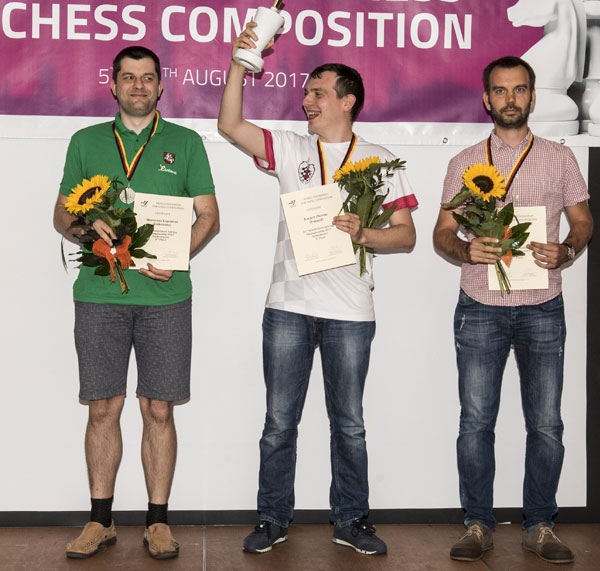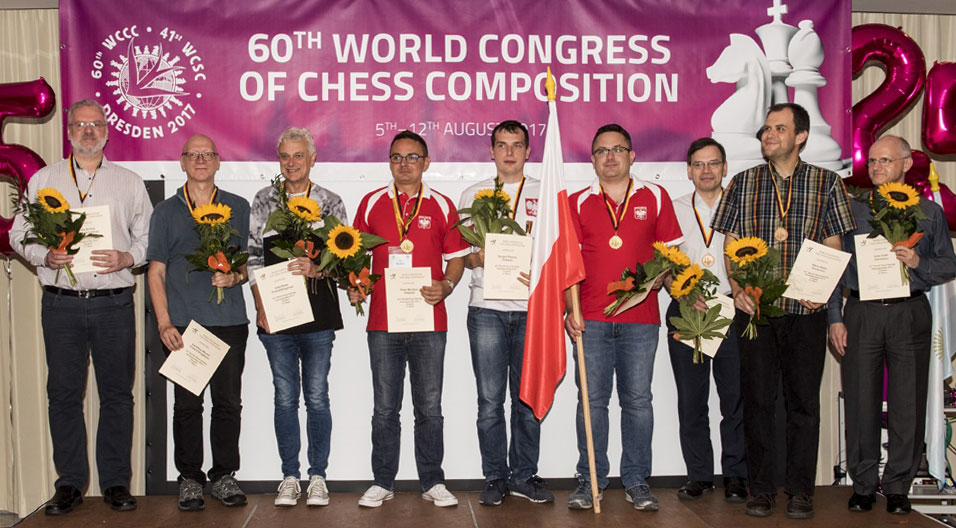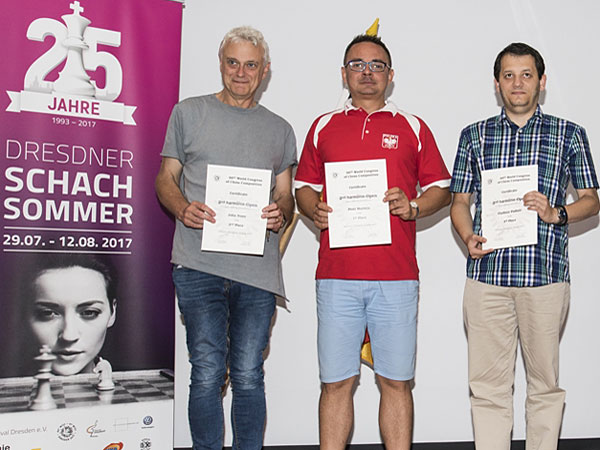Problem solving in Dresden, 2017
By John Nunn — all photographs by Franziska Iseli
The 41st World Chess Solving Championship took place during the second week in August in Dresden, the capital of the German state of Saxony.

In recent years, Dresden has become a major centre for German chess activity and this was the third time I have travelled to the historic city since 2015, the first two visits being for the World Senior Team Championship. I have always enjoyed visiting Dresden and this time was no different.

The Wyndham Garden Hotel, these days a familiar destination for chess players [click to enlarge]
The solving event has been running since 1977 and is a well-established part of the annual World Congress of Chess Competition. The inaugural event was won by Finland, with Pauli Perkonoja taking the individual title. Just 18 individual solvers participated 40 years ago, and since then the event has steadily grown to include 89 solvers in Dresden. I first competed in 1978, finishing second behind Perkonoja, and have taken part 15 times in total, winning three times and finishing in second place on another three occasions.
In the current decade, the team event has been utterly dominated by Poland, who have won every year since 2009. The individual event has been won by either Piotr Murdzia or Kacper Piorun (both Poles) 13 times in the last 15 years, the only breaks in the sequence being my own wins in 2007 and 2010. Since Poland were again fielding their top team in Dresden, there wasn’t much doubt about the destination of first place, but the fight for the silver and bronze medals was expected to be close.
The day before the World Championship starts, there is always an Open Championship, in which anyone can participate (the World Championship itself is for solvers nominated by each country). This warm-up event allows a wider range of participants and has proved extremely popular, this year attracting 114 entrants.

Eleven-year-old solver Chinguun Sumiya from Mongolia finished a creditable 96th
I felt that I had done well in the Open Solving and when the marks were announced I was delighted to have scored 100%, but to my astonishment I only finished second as Piotr Murdzia had also scored 100% and had done so 14 minutes quicker than I — a remarkable performance. The image at the top of this report shows the winners in the Open event: John Nunn (2nd), Piotr Murdzia (1st) and Vladimir Podinic (3rd).
There was an attractive study in the Open event, which you may like to solve.
The next day we were on to the serious business, the World Championship itself, which lasts a total of two days, with three rounds each day.
The very first round consists of three mates in two, which have to be solved in 20 minutes. Although Axel Steinbrink, who set the problems, chose a rather sneaky one to start with, the leading solvers coped with this and all scored 100%. Here is the most attractive of the three. To simulate championship conditions, give yourself seven minutes to find the solution.
The second round of mates in three proved more troublesome, and a number of solvers, myself included, dropped points through missing variations. In problem-solving events you have to give complete solutions, including all variations, in order to score full marks on a problem. It’s quite easy to overlook a relatively minor line and drop a point or two.
The following problem from this round should appeal to over-the-board players.
The third round of endgame studies generally causes quite a few problems, especially for problemists who are not always strong over-the-board players. At one time I could count o gaining a lot of ground in the study round, but these days most of the leading solvers are also good OTB players (there were several over-the-board IMs and GMs competing at Dresden) so this advantage has more or less disappeared.
Here’s an endgame study from this round which features a common over-the-board tactical idea, but in a very unusual setting.
The first day ended with Poland in first place on 87.5 points (out of 90), ahead of Great Britain on 84.5 and Serbia on 82.5. Two individual solvers had 100% scores (45/45), Marko Filipovic (Croatia) and Martynas Limontas (Lithuania). I lay in sixth place on 40.5 points.
The second day began with the helpmate round. This round varies greatly in difficulty from one competition to another; sometimes it is quite easy but sometimes really tough. This one was somewhere in between, with five solvers (including myself) scoring 100%. It’s usually the long helpmate which causes the trouble, but this time a number of leading solvers tripped on the following helpmate in 3.
In a helpmate, both sides are cooperating to help White mate Black (although the moves still have to be legal). Black moves first, with White mating Black on his third move, so the sequence of moves goes B W B W B W mates. There are two parts to this problem, as given below.
The second part is the same problem with the black queen on c6 and not c5:
The moremover round proved my downfall, since I failed to solve a fairly straightforward mate in 8, and this allowed Kacper Piorun to take over the leading position by scoring full marks. Here’s a neat mate in 4 which shouldn’t prove too challenging.
The final selfmate round didn’t change much, as the leading solvers did well on the two shorter problems while a selfmate in 7 was so tough that only one solver manged any points at all on it. Here’s the selfmate in two, not too hard but with a few traps to be avoided.
In a selfmate, White is trying to commit suicide by forcing Black to mate him. Black is doing his best to avoid mating White. White plays first, and must force Black to give mate on his second move.
So Kacper Piorun retained his world championship title, which he has now won four years in a row. Second place went to Lithuanian Martynas Limontas, while Marko Filipovic from Croatia finished third. I ended up in fourth place, just half a point behind Filipovic.

The winners of the individual championship: Martynas Limontas (2nd), Kacper Piorun (1st) and Marko Filipovic (3rd).
In the team event, Poland inevitably won again but the British team scored their best result for several years by finishing second, boosted by good results from Jonathan Mestel and myself. Germany also did well, taking the bronze medals.

From left to right: McNab, Mestel, Nunn (GB team), Murdzia, Piorun, Mista (Polish team), Tummes, Silvio Baier, Zude (German team) – click to enlarge
Then there was the Seniors prize. In over-the-board play there are two age groups, over 50 and over 65, but in solving there is just the one category, over 60. This category is starting to become much stronger, as top solvers such as Mestel, Caillaud, Comay and Kovacevic are now eligible. In a close struggle, I managed to retain the title I have held for the previous two years.

Senior section: Jonathan Mestel (2nd), John Nunn (1st) and Michel Caillaud (3rd)

Axel Steinbrink, who set the problems for the competition.

Russian solver Danila Pavlov, also a successful over-the-board player, won the junior prize and, at age 14, became the youngest-ever International Master of solving
More information is available at wccc2017.de. Here you can download the full team and individual results, all the problems without solutions (so you can try them yourself) and of course the solutions. And here is the full bulletin of the WCCC, including all the solving events.

The U.K. team, Colin McNab, Jonathan Mestel and John Nunn, were sponsored by Winton Group, an investment management company
Solve the problems in the ChessBase replayer
Some of the problems given above are quite hard to solve. If you have not succeeded using the ChessBase Living Diagrams you can try solving them with the ChessBase replayer:
|

You probably know that you can move pieces on our replay boards to analyse, and even start an engine to help you. You can maximize the replayer, auto-play, flip the board and even change the piece style in the bar below the board. At the bottom of the notation window on the right there are buttons for editing (delete, promote, cut lines, unannotate, undo, redo) save, play out the position against Fritz and even embed our JavaScript replayer on your web site or blog. Hovering the mouse over any button will show you its function. |
You can also download a PGN of the selected problems without solutions but with pointers by John Nunn to help you solve them, e.g. with ChessBase or a Fritz-compatible program. Full solutions with explanations will be provided by the author in a separate article, shortly.

John Nunn is a director of Gambit Publications, a leading chess book publisher. They have some interesting new books out this year.
In his day, Lajos Portisch was known for his meticulous opening preparation and in this book he opens his files and shows how key ideas in the Ruy Lopez have evolved from the 1960s to the current era. See GambitBooks.com for more information.

Yochanan Afek, a Grandmaster of Composition and an over-the-board International Master, explores the world of extreme chess tactics, using a host of entertaining examples from over-the-board play and the world of endgame studies. See this page for more information.
These two Gambit books are available in print, Kindle and app form. Using the app, which is available for iOS and Android devices, you can play over all the moves on-screen.






































